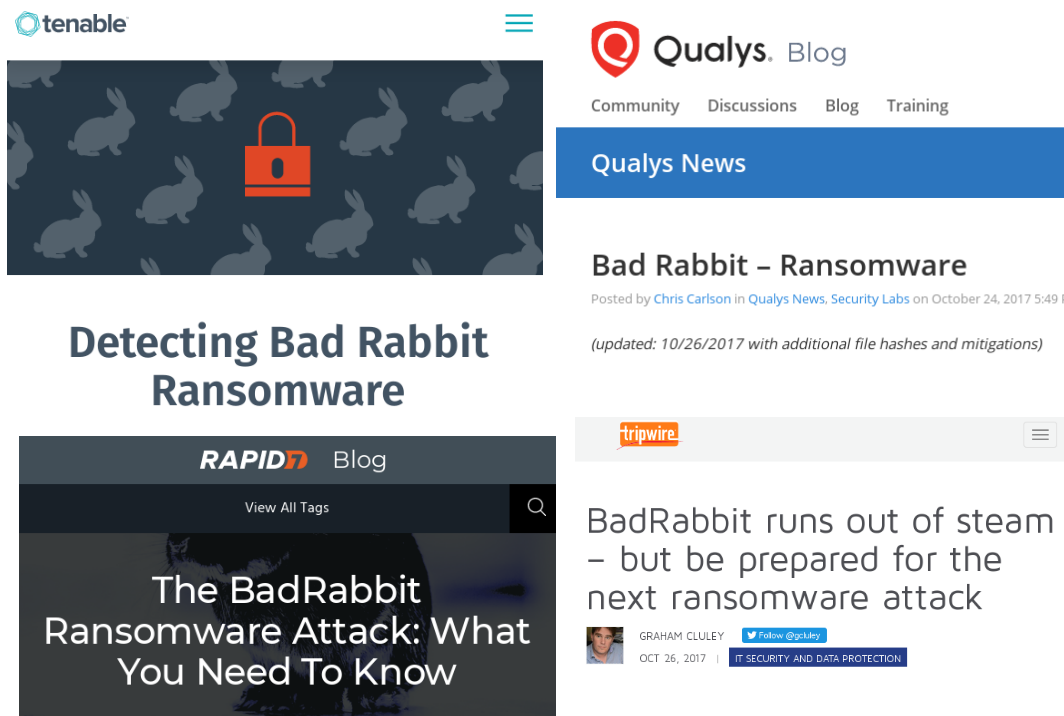Vulnerability Management vendors and massive Malware attacks (following the Bad Rabbit). After the latest Bad Rabbit ransomware attack all Top VM vendors Qualys, Tenable, Rapid7 wrote blog posts on this topic on the same day. Two days later Tripwire also published own review. Why do they care? They do not make antiviruses, endpoint protection or firewalls – the common tools against this kind of threats. So, what’s the point?

Well, they do it is obviously to promote their products and services. But how exactly?
Vulnerabilities
To be functional, malware may exploit vulnerabilities in unpatched systems. These lacks of patching can be detected by Vulnerability Scanner via authenticated and unauthenticated checks.
For example, Bad Rabbit malware uses well-known SMBv1 exploit and Tenable informs us in “Detecting Bad Rabbit Ransomware” post that vulnerability can be detected using plugins:
- 97737 – MS17-010: Security Update for Microsoft Windows SMB Server (4013389) (ETERNALBLUE) (ETERNALCHAMPION) (ETERNALROMANCE) (ETERNALSYNERGY) (WannaCry) (EternalRocks) (Petya)
- 97833 – MS17-010: Security Update for Microsoft Windows SMB Server (4013389) (ETERNALBLUE) (ETERNALCHAMPION) (ETERNALROMANCE) (ETERNALSYNERGY) (WannaCry) (EternalRocks) (Petya) (uncredentialed check)
Indicators of Compromise
Infected hosts have indicators of compromise – files, windows registry keys and values, processes. All of them can be checked using a vulnerability scanner. Thus, VM can be a tool for detecting compromised hosts. This feature is pretty popular now among VM vendors.
In Bad Rabbit case Qualys recommends to search files using QID 1043 check:
- %windir%\infpub.dat
- %windir%\dispci.exe
- %windir%\cscc.dat
Qualys also provide hashes for detecting files in Indication of Compromise (IOC) mode. Hashes for these files were mentioned:
- install_flash_player.exe
- C:\Windows\dispci.exe
- C:\windows\infpub.dat
- C:\windows\cscc.dat [32 drv]
- C:\windows\cscc.dat [64 drv]
- mimikatz x86
- mimikat x64
Tenable Security detects compromised hosts using plugins:
Misconfigurations
To be functional, malware may exploit systems that were not configured correctly. Most of modern Vulnerability Scanners can perform configuration/compliance checks.
BadRabit malware uses mimikatz to extract plaintext passwords from memory for further spreading. Thus, VM vendors could write something about Windows hardening, for example based on “Defending Against Mimikatz” article, right?
But none of them actually gave a direct recommendations. Only Tripwire gave a link to a list of “22 Ransomware Prevention Tips“. Here I would like to mention a great compliance management tool ComplianceCheck by AltxSoft, that was promoted as a solution against ransomware (“Altx-Soft ComplianceCheck against cryptolockers and ransomware“).
In conclusion
Ransomeware attacks, that we all have seen this year (WannaCry, Petya and now Bad Rabbit) are all pretty similar from Vulnerability Management point of view. Should VM vendors react on each of them? IMHO, yes, they should. But it depends on what kind of report it will be.
The common words about of malware behavior are not really interesting. Endpoint / antivirus / threat intelligence vendors, like Kaspersky, Eset or Cisco Talos with all theirs skill in malware research will make a better report anyway.
As an end-user of VM solution, I like when the vendor use all this hype around the malware attack to demonstrate:
- Why this attack was actually possible? (Vulnerabilities)
- Concrete ways to mitigate risk using vendor’s product. (It is much more effective then any kind of training)
- A sign that vendor’s product is still in active phase of development and is not abandoned.(The most important!)

Hi! My name is Alexander and I am a Vulnerability Management specialist. You can read more about me here. Currently, the best way to follow me is my Telegram channel @avleonovcom. I update it more often than this site. If you haven’t used Telegram yet, give it a try. It’s great. You can discuss my posts or ask questions at @avleonovchat.
А всех русскоязычных я приглашаю в ещё один телеграмм канал @avleonovrus, первым делом теперь пишу туда.

Pingback: ZeroNights 2017: back to the cyber 80s | Alexander V. Leonov
Pingback: SOC Forum 2017: How I Learned to Stop Worrying and Love Massive Malware Attacks | Alexander V. Leonov
Pingback: Microsoft security solutions against ransomware and APT | Alexander V. Leonov
Pingback: MIPT/PhysTech guest lecture: Vulnerabilities, Money and People | Alexander V. Leonov